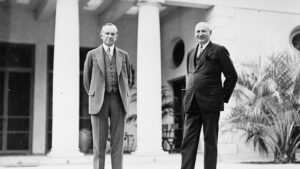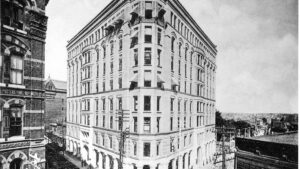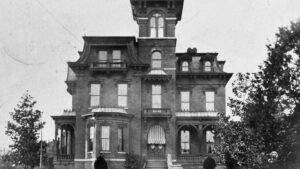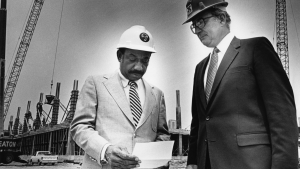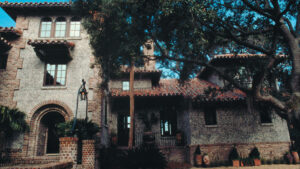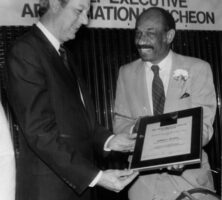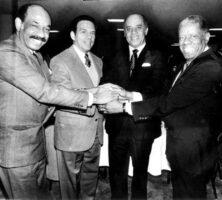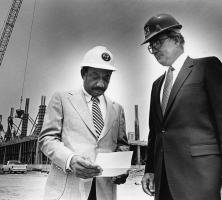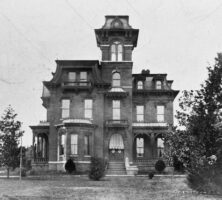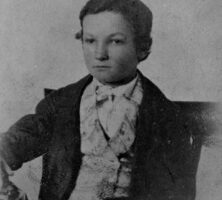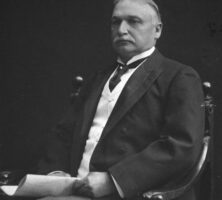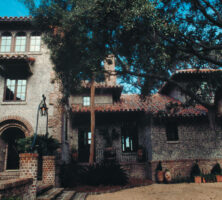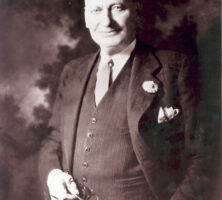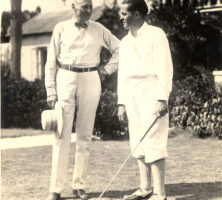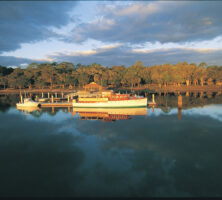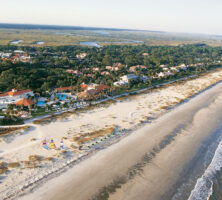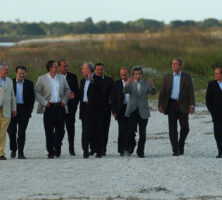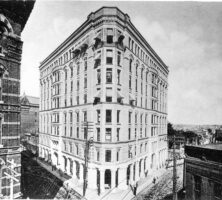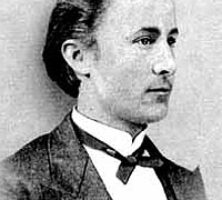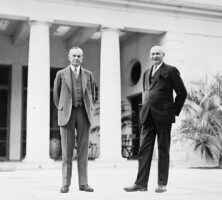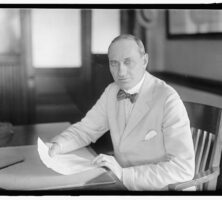The New Georgia Encyclopedia is supported by funding from A More Perfect Union, a special initiative of the National Endowment for the Humanities.
Georgia governor Joe Frank Harris (left) presents Herman J. Russell, an Atlanta entrepreneur and community leader, with the award for the Atlanta Business League's CEO of the Year in 1986.
Courtesy of Archives Division, Auburn Avenue Research Library on African American Culture and History, Atlanta-Fulton Public Library System, Harmon Perry Photograph Collection.
The New Georgia Encyclopedia does not hold the copyright for this media resource and can neither grant nor deny permission to republish or reproduce the image online or in print. All requests for permission to publish or reproduce the resource must be submitted to the rights holder.
Three prominent civil rights leaders from Atlanta gather in 1987 to endorse the candidacy of Richard Arrington Jr. for mayor of Birmingham, Alabama. Arrington won the election to become the first Black mayor of that city. From left, Herman J. Russell, Andrew Young, Richard Arrington, and Jesse Hill.
Courtesy of Archives Division, Auburn Avenue Research Library on African American Culture and History, Atlanta–Fulton Public Library System, Harmon Perry Photograph Collection.
The New Georgia Encyclopedia does not hold the copyright for this media resource and can neither grant nor deny permission to republish or reproduce the image online or in print. All requests for permission to publish or reproduce the resource must be submitted to the rights holder.
Herman J. Russell (left), founder of the Atlanta-based construction and real estate conglomerate H. J. Russell and Company, consults in 1983 with developer Robert Holder on plans for the Delta Air Lines building in College Park.
Courtesy of Atlanta Journal-Constitution.
The New Georgia Encyclopedia does not hold the copyright for this media resource and can neither grant nor deny permission to republish or reproduce the image online or in print. All requests for permission to publish or reproduce the resource must be submitted to the Atlanta Journal-Constitution.
The New Georgia Encyclopedia does not hold the copyright for this media resource and can neither grant nor deny permission to republish or reproduce the image online or in print. All requests for permission to publish or reproduce the resource must be submitted to the rights holder.
The Inman family donated a portion of their wealth to many charitable causes in Atlanta, including several colleges, the Confederate Soldiers' Home, Grady Memorial Hospital, and this orphanage.
Courtesy of Atlanta History Center.
The New Georgia Encyclopedia does not hold the copyright for this media resource and can neither grant nor deny permission to republish or reproduce the image online or in print. Requests for permission to publish or reproduce the resource should be submitted to the Atlanta History Center.
Hugh Inman, the youngest son of Shadrach W. Inman, sits for a portrait as a young boy. After the family moved to Atlanta in 1865, Hugh worked with his father to establish a dry goods store in the city.
Courtesy of Atlanta History Center.
The New Georgia Encyclopedia does not hold the copyright for this media resource and can neither grant nor deny permission to republish or reproduce the image online or in print. Requests for permission to publish or reproduce the resource should be submitted to the Atlanta History Center.
Four generations of the Inman family begin with (right to left) Shadrach W. Inman, Samuel M. Inman, Henry Arthur Inman, and Arthur Crew Inman. Shadrach arrived in Atlanta from east Tennessee in 1865 to join his brothers William H. and Walker P. Inman. The Inman family soon became among the most wealthy and prominent in the city.
Courtesy of Atlanta History Center.
The New Georgia Encyclopedia does not hold the copyright for this media resource and can neither grant nor deny permission to republish or reproduce the image online or in print. Requests for permission to publish or reproduce the resource should be submitted to the Atlanta History Center.
Samuel Inman, the oldest son of Shadrach W. Inman, opened a dry goods store in Augusta before becoming, along with his brother Hugh and friend Joel Hurt, an investor in railroads, streetcars, and banks in Atlanta during the 1890s.
Courtesy of Atlanta History Center.
The New Georgia Encyclopedia does not hold the copyright for this media resource and can neither grant nor deny permission to republish or reproduce the image online or in print. Requests for permission to publish or reproduce the resource should be submitted to the Atlanta History Center.
The Cloister (1928), a resort on Sea Island, was designed by architect Addison Mizner. The structure is representative of the Spanish-style architecture popular in Georgia during the 1920s.
Courtesy of Sea Island Company
The New Georgia Encyclopedia does not hold the copyright for this media resource and can neither grant nor deny permission to republish or reproduce the image online or in print. All requests for permission to publish or reproduce the resource must be submitted to the rights holder.
Howard Coffin was an automobile and aviation pioneer and the founder of the Sea Island Company. He also led the effort to declare nearby Fort Frederica a national monument.
Courtesy of Sea Island Company
The New Georgia Encyclopedia does not hold the copyright for this media resource and can neither grant nor deny permission to republish or reproduce the image online or in print. All requests for permission to publish or reproduce the resource must be submitted to the rights holder.
Sea Island Company founder Howard Coffin (left) with golf champion Bobby Jones at the Sea Island Golf Club, 1930.
Courtesy of Sea Island Company
The New Georgia Encyclopedia does not hold the copyright for this media resource and can neither grant nor deny permission to republish or reproduce the image online or in print. All requests for permission to publish or reproduce the resource must be submitted to the rights holder.
A vintage yacht is docked at Cabin Bluff, a 50,000-acre hunting preserve in Camden County.
Courtesy of Sea Island Company
The New Georgia Encyclopedia does not hold the copyright for this media resource and can neither grant nor deny permission to republish or reproduce the image online or in print. All requests for permission to publish or reproduce the resource must be submitted to the rights holder.
An aerial view of Sea Island shows a relatively undeveloped area, still retaining much of its natural beauty.
Courtesy of Sea Island Company
The New Georgia Encyclopedia does not hold the copyright for this media resource and can neither grant nor deny permission to republish or reproduce the image online or in print. All requests for permission to publish or reproduce the resource must be submitted to the rights holder.
Sea Island hosted the 2004 G8 Summit. From left, Bertie Ahern of the European Union, Romano Prodi of the European Commission, Tony Blair of the United Kingdom, Jacques Chirac of France, Paul Martin of Canada, Gerhard Shroeder of Germany, Vladimir Putin of Russia, Junichiro Koizumi of Japan, George W. Bush of the United States, and Silvio Berlusconi of Italy.
Courtesy of Atlanta Journal-Constitution.
The New Georgia Encyclopedia does not hold the copyright for this media resource and can neither grant nor deny permission to republish or reproduce the image online or in print. All requests for permission to publish or reproduce the resource must be submitted to the Atlanta Journal-Constitution.
John Wellborn Root's eight-story Equitable Building in Atlanta, built in the early 1890s for the developer Joel Hurt, was demolished in 1971, just as Georgia's historic preservation movement was getting under way. Its steel-frame construction and monumental presence made it the city's pioneer skyscraper.
The New Georgia Encyclopedia does not hold the copyright for this media resource and can neither grant nor deny permission to republish or reproduce the image online or in print. Requests for permission to publish or reproduce the resource may need to be submitted to the Georgia Department of Community Affairs, Historic Preservation Division.
Atlanta businessman Joel Hurt was involved in real estate, insurance, and streetcars. He was responsible for the construction of three major buildings in downtown Atlanta, including the Hurt Building and the Equitable Building.
Courtesy of Atlanta Historical Society
The New Georgia Encyclopedia does not hold the copyright for this media resource and can neither grant nor deny permission to republish or reproduce the image online or in print. All requests for permission to publish or reproduce the resource must be submitted to the rights holder.
The Hurt Building, named for Atlanta developer Joel Hurt and completed in 1926, was the seventeenth-largest office building in the world; still standing, it remains a distinctive Atlanta landmark.
Photograph by Ganeshk
The New Georgia Encyclopedia does not hold the copyright for this media resource and can neither grant nor deny permission to republish or reproduce the image online or in print. All requests for permission to publish or reproduce the resource must be submitted to the rights holder.
Detroit automotive engineer Howard Coffin (right) visits with U.S. president Calvin Coolidge (left) on the porch of "The Big House"—the south-end tabby-stucco structure originally built by Thomas Spalding in 1810. Coffin owned much of Sapelo Island from 1912 to 1934.
Courtesy of Georgia Archives, Vanishing Georgia, # sap118.
The New Georgia Encyclopedia does not hold the copyright for this media resource and can neither grant nor deny permission to republish or reproduce the image online or in print. Requests for permission to publish or reproduce the resource should be submitted to the Georgia Archives.
Howard Coffin, a pioneer in the automobile industry, is credited with revitalizing Georgia's coast as a popular tourist destination. In the early 1900s Coffin owned all or part of Sea, St. Simons, and Sapelo islands.
Courtesy of Library of Congress, Prints and Photographs Division, Harris & Ewing collection.
The New Georgia Encyclopedia does not hold the copyright for this media resource and can neither grant nor deny permission to republish or reproduce the image online or in print. All requests for permission to publish or reproduce the resource must be submitted to the rights holder.
The New Georgia Encyclopedia does not hold the copyright for this media resource and can neither grant nor deny permission to republish or reproduce the image online or in print. All requests for permission to publish or reproduce the resource must be submitted to the rights holder.
